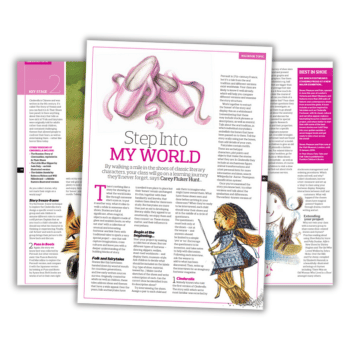Three-page PDF featuring cross-curricular KS2 activity ideas
KS2
Years 3-6
By walking a mile in the shoes of classic literary characters, your class will go on a learning journey they’ll never forget. Use this traditional tales KS2 planning PDF to get started…
There’s nothing like a story for showing us what the world looks like through someone else’s eyes or, to put it another way, what it’s like to walk a while in someone else’s shoes.
Stories are full of significant, often magical, objects such as slippers made of glass and sealskin boots. Why not start with a collection of unusual and interesting footwear and link them with traditional tales to spark a very special project?
This project will capture imaginations, cross cultures and leave you with a deeper understanding of the building blocks of story.
Traditional tales KS2 planning
Stories like this have been handed down by word of mouth for countless generations, and few early written sources survive.
Originally created for adults as well as children, these tales address ideas and themes that have a wide appeal.
Why plan around traditional tales in KS2?
Over the years, folk and fairytales have travelled from place to place but their ‘bones’ remain unchanged. It’s this, together with their familiarity and brevity, that makes them ideal for classroom study.
But fairytales are more than just an aid to developing literacy skills; they appeal to us emotionally, we enjoy them and they connect us.
These stories matter, and their influence is everywhere.
Starter activity
Start your project by making a collection of shoes. Borrow different types of footwear – dancing slippers, wellies, steel-toed workboots – and display them, museum-style.
Ask children to decide what should be included on the labels (e.g. type of shoe, material, loaned by…) Make careful sketches of the shoes and write a description of each. Can the correct shoe be identified from its description alone?
Try interviewing the shoes. Assign a pair to each child and ask them to imagine who might have owned them. What have these shoes seen and done before arriving in your classroom?
When they’re ready to be interviewed, each child should wear their shoes and sit in the middle of a circle of questioners.
The questioners must look only at the shoes – not at the wearer – and answers should be limited to a simple ‘yes’ or ‘no’.
Encourage the questioners to be inventive, and take notes to help with discussion. Following each interview, ask the wearer to add to what has been discovered. Then, write up the interviews for an imaginary footwear magazine.
Carey Fluker Hunt is creative projects manager at Seven Stories, the Centre for Children’s Books in Newcastle upon Tyne. Find out more about Seven Stories at sevenstories.org.uk. Browse more traditional tales resources.

Similar resources
- No Refuge – Graphic novel activities about refugees for UKS2
- Short story writing – Author-led resources for KS1 and KS2
- Christmas activity sheets – KS1 / KS2 fun & educational printables
- Learning gaps – How to ensure no pupil drifts too far
- Writing horror – Write a scary scene with Fear Files: Hide & Seek










